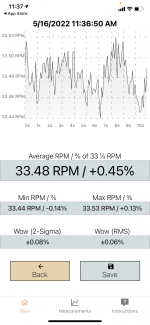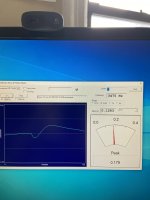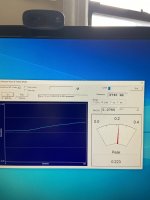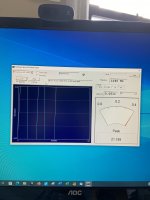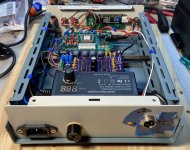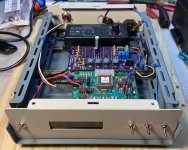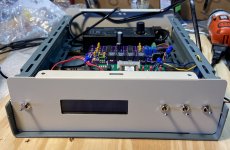I just checked the speed/wow/flutter with a real test record and a computer program. Seems that the “yellow” ios RPM app is lying. It’s reading too high. The “blue” app is a lot closer to truth. And there’s a new app which reads decent RMS, so this table isn’t horrible. I have to find what is causing high peaks every revolution. Rms seems to be in 0.05 - 0.07 area, not bad. Most peaks hit 0.12
I use either while lithium, or pfte grease.Try front axle (CV joint) grease for the thrust bearing.
Good to 140 C, does not dry out fast.
The noise source seems to be the platter bearing.
Easily available at auto parts stores, quite low priced as well.
Great results. Here’s mine:Here's the result of my test; not as good as my Technics SP10 mk II (0.02%), but pretty good for a belt drive
Attachments
Does your bearing and well point up or down? My bearing, a single ceramic ball, points down and sits in a well. Grease increased the friction A LOT, oil worked as expected.I use either while lithium, or pfte grease.
Points up, it’s an inverted, or upside-down bearing, zirconium ball pointing up, sitting under small sapphire thrust plate.Does your bearing and well point up or down? My bearing, a single ceramic ball, points down and sits in a well. Grease increased the friction A LOT, oil worked as expected.
If you send me a file with that recording, I'll test on my FL140.Thank you. I’ve tried different belts. I’ve recorded a 3000 hz test time of of my test record. It’s about 3 min long, 1.4 Mb. If anyone can use this recording to measure w/f I’d really appreciate it.
I agree 100%. Very poor bearing design. Inverted bearing MUST oil channels bringing oil up, like Basis and old Audiomeca, from oil bath. I’ve also tried to fix this on a free with no success. But I’ve also seen a few with very low W/f figures. Go figure…At the risk of causing a firestorm, I've seen this problem on 3 or 4 SOTA tables I've restored. It's one of the reasons I no longer will touch them. Heresy, I know.
Thank you very much! I will need your email I guess, the file is 1.4 MbIf you send me a file with that recording, I'll test on my FL140.
An inverted bearing needs an oil circulation system.
Grease is a better option, try different greases, PTFE or silicon grease with low viscosity but good adhesion to metal is needed.
Grease is a better option, try different greases, PTFE or silicon grease with low viscosity but good adhesion to metal is needed.
Thx to all on this thread, especially Pyramid! Build complete. I may change to pusg-buttons later.
Attachments
Hi all. A minor problem (I think): when I press “start”, for the guest sending I can hear the belt slipping on pulley, until platter catches up. It’s a factory Sota pulley and belt. I remember reading somewhere in the threads, that motor should start at only 5v, preventing belt wear. I can see by the current draw that motor pulls about 800 ma at start, and after a second or two it drops to 340 ma. Is anything wrong with my build?
Will do. Platter is heavy, so motor is “spinning wheels” ))). Anyway to make it start slower?Starting torque...give a push with your hand at start, see what happens.
I used a non-factory larger diameter pulley with a round belt before, and it was better. So this may be a temporary solution for now.You need a high current soft starter type device...read about those, and modify your circuit.
Btw, to all who are looking for a pulley: Donna at Sota will graciously sell their factory Eclipse pulley, designed for 1/4” shaft, flat belt, and 12” platter. It is aluminum and has two securing bolts. I have her permission to publish this info.
That’s what I thought )))1 - 2 seconds is not worth the hassle, just keep a spare belt around.
- Home
- Source & Line
- Analogue Source
- 3 Phase Class D amp for DIY BLDC motor Drive
